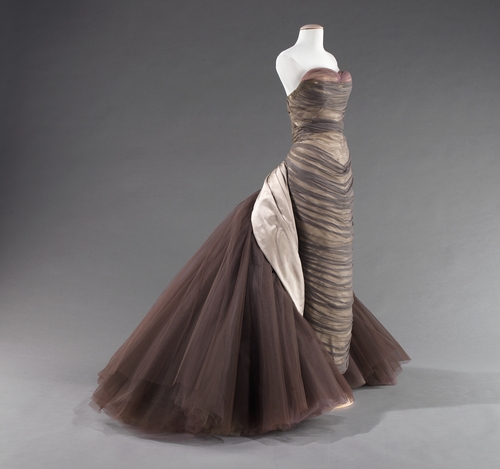Born: Camberley, England, of Anglo-American parentage, 18 July 1906. Education: Self-taught in design. Family: Married Nancy Lee Gregory in 1954 (separated, 1961); children: Charles, Louise. Career: Moved to U.S., established as Charles Boucheron, milliner, Chicago, 1924-28; milliner and custom dressmaker, New York, 1928-29; custom dressmaker, using the name E. Haweis James, London and Paris, 1929-circa 1939; also sold designs to wholesale manufacturers in New York, 1930s; relocated to New York, 1939; established as Charles James, Inc., primarily for custom designs, from 1940; became permanent resident of the United States, 1942; designer, couture collection, Elizabeth Arden salon, New York, 1943-45; worked as independent designer, 1945-78; Charles James Services, Inc., licensing company established, 1949; Charles James Associates, limited partnership for manufacture of custom clothes, established, 1954, then merged with Charles James Services; Charles James Manufacturers Company established, 1955. Exhibitions: A Decade of Design, Brooklyn Museum, 1948; A Total Life Involvement (retrospective), Everson Museum, Syracuse, New York, 1975; The Genius of Charles James (retrospective), Brooklyn Museum and Art Institute of Chicago, 1982-83; Charles James, Architect of Fashion, Fashion Institute of Technology, New York, 1993. Awards: Coty American Fashion Critics award, 1950, 1954; Neiman Marcus award, Dallas, 1953; Woolens and Worsteds of America Industry award, 1962; John Simon Guggenheim fellowship, 1975; inducted to Fashion Walk of Fame, Seventh Avenue, New York, 2001. Died: 23 September 1978, in New York
"Charles James is not only the greatest American couturier, but the world's best and only dressmaker who has raised it from an applied art form to a pure art form." From anyone other than their author, and James' closest professional equal, Cristobal Balenciaga, these words would seem potentially pretentious and inflated. Instead they constitute a balanced and deserved evaluation.
Charles Wilson Brega James was of Anglo-American parentage and possessed an incredibly sharp mind. He could have excelled in any number of fields but a foray into millinery in Chicago of the 1920s led to a career devising intellectually refined and devastatingly beautiful women's garments. James' lifetime career was devoted not to producing quantities of either designs or products but rather to refining and evolving concepts. His clientéle in Britain, France, and the U.S. was dedicated: they put up with his unpredictability and his inflated costs. When they ordered a garment there was no guarantee of its delivery or its permanence in their wardrobe as the designer would freely play roulette with his clients' clothes.
Why did clients remain loyal? Why is the word "genius" applied so frequently in describing James? Because James saw the female form as an armature on which to fashion sculpture, not just cover with clothes. He did not just sketch or drape a model. He approached the craft of dressmaking with the science of an engineer, often studying the weight distribution of a garment. Like an artist he analyzed the interacting elements of proportion, line, color, and texture. Construction details were not merely important, they were an obsession. He spent a vast sum on perfecting a sleeve. He turned a four-leaf clover hat into the hemline of a ballgown which he then built up into the garment he designated as his thesis in dressmaking.
A cruciform became a circular skirt; an evening dress (with matching cape of antique ribbons) which made its debut in 1937 was still offered 20 years later, the finesse of the ribbon replaced by other yardgoods of silk, but the detailing to infinity remaining. James was such a perfectionist that clients never banked on wearing either a new or old James to a function. Even his well-known quilted jacket designed in 1937, and now in the London's Victoria and Albert Museum, bears witness to his challenge to perfect. One can follow his tortured, ghost-like tracts of stitching and restitching.
As brilliant as his design sense was James' subtle sensibility of color. Open a coat or jacket of subdued hues and be confronted with a lining of an unexpected range. Follow his curvilinear pattern configu-rations and note that inset sleeves and darts are not part of either his design or construction vocabulary. His lines are seductive and intellectually intriguing. Rarely did he employ patterned materials, relying rather on the most revealing, unforgiving plain goods. While he is perhaps best remembered for his spectacular eveningwear, his tailored daywear was equally original. It was with his coats that he attempted to enter what he perceived to be the more lucrative ready-to-wear market. This, however, didn't suit his temperament or methods of working.
James dressed many of America's best-dressed women of the generation. They patronized the couture salons of Paris and could easily have been dressed abroad. Instead they had the courage and determination to support a unique creator of fashion: Charles James...




















At this time it seems like Movable Type is the
ReplyDeletepreferred blogging platform out there right now. (from what I've read) Is that what you are using on your blog?
Visit my web blog : accessori nautica
Hi there! Would you mind if I share your blog with my zynga group?
ReplyDeleteThere's a lot of folks that I think would really enjoy your content. Please let me know. Cheers
Here is my homepage - Bud trimmer
An intriguing discussion is worth comment. I think that you need to publish more on this issue,
ReplyDeleteit may not be a taboo matter but generally people do not talk
about these subjects. To the next! All the best!
!
Here is my web blog FinderHostel.com
What's up, everything is going nicely here and ofcourse every one is sharing data, that's genuinely excellent, keep up writing.
ReplyDeletemy page st augustine mma schools
Hello, just wanted to mention, I liked this blog post.
ReplyDeleteIt was inspiring. Keep on posting!
Feel free to visit my web site twitter